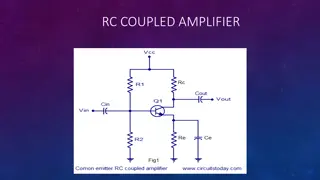Understanding Transistor Bias Circuits for Linear Amplification
Transistor bias circuits play a crucial role in setting the DC operating point for proper linear amplification. A well-biased transistor ensures the signal variations at the input are accurately reproduced at the output without distortion. Various biasing methods such as Voltage-Divider Bias, Emitter Bias, Base Bias, Emitter-Feedback Bias, and Collector-Feedback Bias are essential for establishing the Q-point. Proper biasing guarantees the transistor operates in its linear region, enhancing its performance as a linear amplifier.
Download Presentation

Please find below an Image/Link to download the presentation.
The content on the website is provided AS IS for your information and personal use only. It may not be sold, licensed, or shared on other websites without obtaining consent from the author. Download presentation by click this link. If you encounter any issues during the download, it is possible that the publisher has removed the file from their server.
E N D
Presentation Transcript
Term 2, Lecture 4: Transistor Bias Circuits The DC Operating point: A transistor must be properly biased with a dc voltage in order to operate as a linear amplifier. A dc operating point must be set so that signal variations at the input terminal are amplified and accurately reproduced at the output terminal. As you learned, when you bias a transistor, you establish the dc voltage and current values. This means, for example, that at the dc operating point, IC and VCE have specified values. The dc operating point is often referred to as the Q-point (quiescent point) or (silent) point because it is a point on IC VCEcharacteristic when the transistor is silent or no ac input signal is applied to the circuit. Linear Operation The region along the load line including all points between saturation and cutoff is generally known as the linear (or active) region of the transistor s operation. As long as the transistor is operated in this region, the output voltage is ideally a linear reproduction of the input. Bias establishes the dc operating point (Q-point) for proper linear operation of an amplifier, the ac signal moves above and below this point. If an amplifier is not biased with correct dc voltages on the input and output, it can go into saturation or cutoff when an input 1
signal is applied. Example below shows the linear operation of a transistor, the dc base current is 300 A. When the input causes the base current to vary between 200 A and 400 A, the collector current varies between 20 mA and 40 mA depending on the equation IC= Beta dc * IB. A signal that swings outside the active region will be clipped. For example, the bias has established a low Q point. As a result, the signal will be clipped because it is too close to cutoff, as shown in figure below: 2
Example: 4
Transistor Biasing is the process of setting a transistors DC operating voltage or current conditions to the correct level so that any AC input signal can be amplified correctly by the transistor. The steady state operation of a transistor depends a great deal on its base current, collector voltage, and collector current values and therefore, if the transistor is to operate correctly as a linear amplifier, it must be properly biased around its operating point. Establishing the correct operating point requires the selection of bias resistors and load resistors to provide the appropriate input current and collector voltage conditions. 5
There are five methods to establish the Q point that as follows: 1. Voltage - Divider Bias: It is a method of biasing a transistor for linear operation using a single source (VCC) resistive voltage divider. This is the most widely used biasing method. 2. Emitter Bias. 3. Base Bias. 4. Emitter-Feedback Bias. 5. Collector-Feedback Bias. This mode of operation allows the output voltage to increase and decrease around the amplifiers Q-point without distortion as the input signal swings through one complete cycle. In other words, the output is available for the full 360o of the input cycle. These bias circuits you will take them as experiments in the electronic laboratory in the second year with God willing "In Sha a Allah . 6
Review Questions: 1. What are the upper and lower limits on a dc load line in terms of VCEand IC? 2. Define Q-point. 3. At what point on the load line does saturation occur? At what point does cutoff occur? 4. For maximum Vce, where should the Q-point be placed? 5. Name the transistor bias circuits and which of them is the commonly used? 7






















